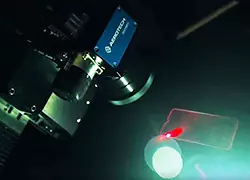In any system requiring precise straight-line movement, the mechanical element responsible for smooth, repeatable guidance is the linear bearing. These components are essential in machine design, particularly in automation and manufacturing, where they ensure that movement is both accurate and low-friction. Answering the question “what is a linear bearing?” is key to appreciating the engineering behind high-performance machinery.
For a detailed look at the stages these components support, visit our guide on the precision linear stage. The necessity of low-friction guidance is a fundamental design principle across all precision stages.
What Is a Linear Bearing?
A linear bearing is a component that allows smooth, low-friction motion along a straight path. Its function is crucial to any translational motion system. It guides and supports a moving load on a linear stage or actuator while minimizing resistance and wear. By allowing the carriage to glide effortlessly along the rail, the bearing reduces the force required from the motor, while constraining the motion to one degree of freedom.
Linear bearings are designed to support loads while providing minimal friction. This support is achieved by using rolling elements (balls or rollers) or a cushion of air in advanced designs. The combination of linear bearings and rails are often used in conjunction to guide movement. The rail provides the rigid, defined path, while the bearing, often housed in a truck or block, contains the rolling elements that facilitate the motion. The manner in which the rolling elements interact with the truck and the rail is critical for achieving high stiffness, which dictates the dynamic performance and repeatability of the overall motion system.
What Is the Difference Between a Linear Bearing and a Rotary Bearing?
The difference between a linear bearing and a rotary bearing centers entirely on the type of motion each is designed to support.
A linear bearing guides motion along a straight line, minimizing friction and supporting loads in linear stages or actuators. Its design is optimized to handle forces perpendicular to the direction of motion (load) and in all three rotational degrees of freedom, while allowing nearly frictionless movement parallel to the motion path.
A rotary bearing supports and allows smooth rotation around an axis, handling radial and axial loads in shafts, wheels or rotary stages. Rotary bearings, such as ball bearings or roller bearings, are designed to manage forces that are both outward (radial) and along the shaft's axis (axial) during continuous rotation. Understanding linear motion bearing types helps in selecting the right bearing for specific applications, as applying a linear bearing to a rotational application would fail, and vice versa.
What Is an Example of a Linear Bearing?
An example of a linear bearing is a crossed-roller bearing used in high-precision linear stages, which allows smooth, rigid motion along a straight path with minimal play. These bearings use cylindrical rollers oriented perpendicular to each other in a V-groove configuration, offering excellent rigidity and the capability to handle high moment loads.
Crossed roller bearings are another type that provides high rigidity and precision. Other common examples include recirculating ball bearings—also referred to as linear motion guides or truck-and-rail bearings—plus ball bushings and profile rail bearings. An example of a linear bearing is a ball bearing slide used in drawer systems. This simple application demonstrates the bearing's function of guiding a sliding load with reduced effort. The linear bearing application can be found in various industries, including manufacturing and automation, ranging from low-cost general use to ultra-precision metrology where error tolerances are measured in nanometers.
What Are Linear Bearings Used For?
Linear bearings are used to guide and support loads in straight-line motion with minimal friction and high precision. Their application is dictated by the need for reliable translational movement under load. They are common in applications like linear stages, automation equipment, CNC machines, robotics and optics positioning systems.
Linear bearings and rails are essential components in many linear motion systems because they are crucial to maintaining the system's geometric accuracy. In a CNC machine, for instance, linear bearings ensure the cutting tool maintains its intended straight path without lateral deviation (straightness and flatness errors). In ultra-high precision systems, advanced versions such as air bearings are used to eliminate mechanical contact and achieve zero friction, which is necessary for high-speed scanning and contamination-sensitive environments.
Ready to dive deeper into the world of precision stages?


